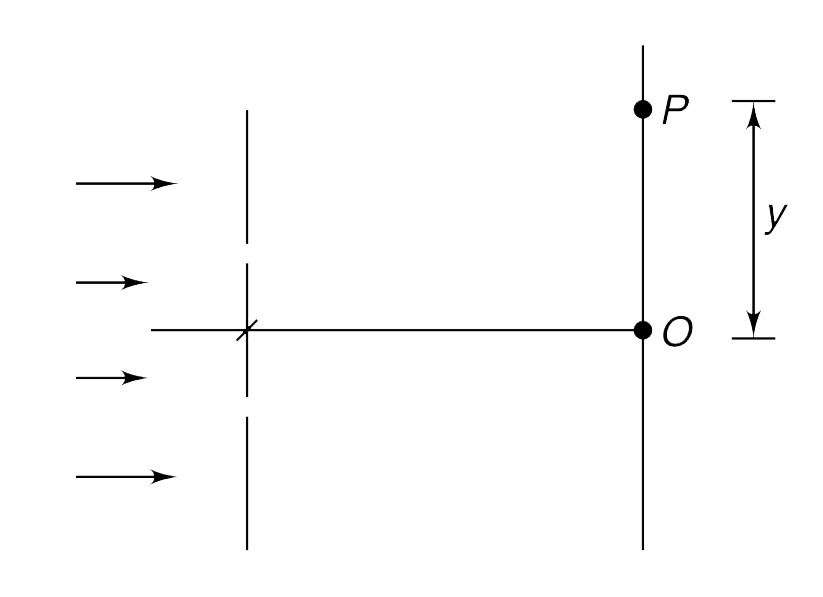If an interfernce pattern,at a point we observe the 16th order maximum for λ1=6000Å. what order will be visible here if the soruce is replaced by light of wavelength λ2=4800Å
The distance of nth maxima from central maxima is given by
yn=nDλd
For yn to be constant nλ= constant. Thus
n1λ1=n2λ2
∴n2=n1λ1λ2=16×60004800=20
Topper's Solved these Questions
- CHAPTERWISE NUMERIC /INTEGER ANSWER QUESTIONSBOOK - DISHA PUBLICATIONCHAPTER - CHAPTERWISE NUMERIC /INTEGER ANSWER QUESTIONSEXERCISE - CHAPTER -25 : (DUAL NATURE OF RADIATION AND MATTER)
15 Videos
- CHAPTERWISE NUMERIC /INTEGER ANSWER QUESTIONSBOOK - DISHA PUBLICATIONCHAPTER - CHAPTERWISE NUMERIC /INTEGER ANSWER QUESTIONSEXERCISE - CHAPTER 26 : (ATOMS)
15 Videos
- CHAPTERWISE NUMERIC /INTEGER ANSWER QUESTIONSBOOK - DISHA PUBLICATIONCHAPTER - CHAPTERWISE NUMERIC /INTEGER ANSWER QUESTIONSEXERCISE - CHAPTER 23 : (RAY OPTICS AND OPTICAL INSTRUMENTS)
15 Videos
- ATOMSBOOK - DISHA PUBLICATIONCHAPTER - ATOMSEXERCISE - EXERCISE-2: CONCEPT APPLICATOR
30 Videos
- COMMUNICATION SYSTEM BOOK - DISHA PUBLICATIONCHAPTER - COMMUNICATION SYSTEM EXERCISE - EXERCISE-2 : Concept Applicator
30 Videos
Similar Questions
In a Young's double slit interference pattern at a point , we observe the 10th bright fringe (order maxima) for wavelength 7000 Å . What order maxima will be visible if the source of light is replaced by light of wavelength 5000 Å?
View SolutionIn a biprism experiment using sodium light λ=6000Å an interference pattern is obtained in which 20 fringes occupy 2 cm. On replacing sodium light by another source of wavelength λ2 without making any other change 30 fringes occupy 2.7 cm on the screen. What is the value of λ2 ?
View Solution
Knowledge Check
In a certain double slit experimental arrangement interference fringes of width 1.0mm each are observed when light of wavelength 5000Å is used. Keeping the set up unaltered, if the source is replaced by another source of wavelength 6000Å, the fringe width will be
A(a) 0.5mmB(b) 1.0mmC(c) 1.2mmD(d) 1.5mmIn young's slit experiment 10thorder maximum is obtained at the point of observation in the interference pattern for λ=7000Å.If the source is replaced by another one of wavelength 5000Åthen the order of maximum at the same point will be-
A12thB14thC16thD18thIn Young's double slit experiment, red light of wavelength of 6000Å is used and the nth bright fringe is obtained at a ponit P on the screen. Keeping the same setting, the source of light is replaced by green light of wavelength 5000Å and now (n+1)th bright fringe is obtained at the point P on the screen. The value of n is
A4B5C6D3
In young’s double slit experiment, when the slit plane is illuminated with light of wavelengthλ1, it was observed that point P is closest point from central maximum O, where intensity was 75% the intensity at O. When the light of wavelength λ2 is used, point P happens to be the nearest point from O where intensity is 50% of that at O. Find the ratioλ1λ2.

View SolutionIn biprism experiment, 10th dark band is observed at 2.09mm from the central bright point on the screen with red light of wavelength 6400Å. By how much will fringe width change if blue light of wavelength 4800Å is used with the same setting ?
View SolutionIf an interference experiment is performed using two wavelengths close to each other, two interference patterns corresponding to the two wavelengths are obtained on the screen. The frings system remains distinct up to a point on the screen where the nth order maximum of one wavelength falls on the nth order minimum of the other wavelength. Suppose in Young's double sit experiment, sodium light composed of two wavelengths λ1andλ2 close to each other (with λ2 greater than λ1) is used. The order n, up to which the fringes can be seen on the screen, is given by
View SolutionIn the interference pattern obtained in a biprism experiment, 5th order bright fringe is obtained at a point on the screen, when monochromatic light of wavelength 6000 Å is used. What is the order of the bright fringe produced at the samme point, if the light of wavelength 5000 Å is used?
View SolutionThe ratio of resolving power of an optical microscope for two wavelength λ1=4000Å and λ2=6000Å is:
View Solution
